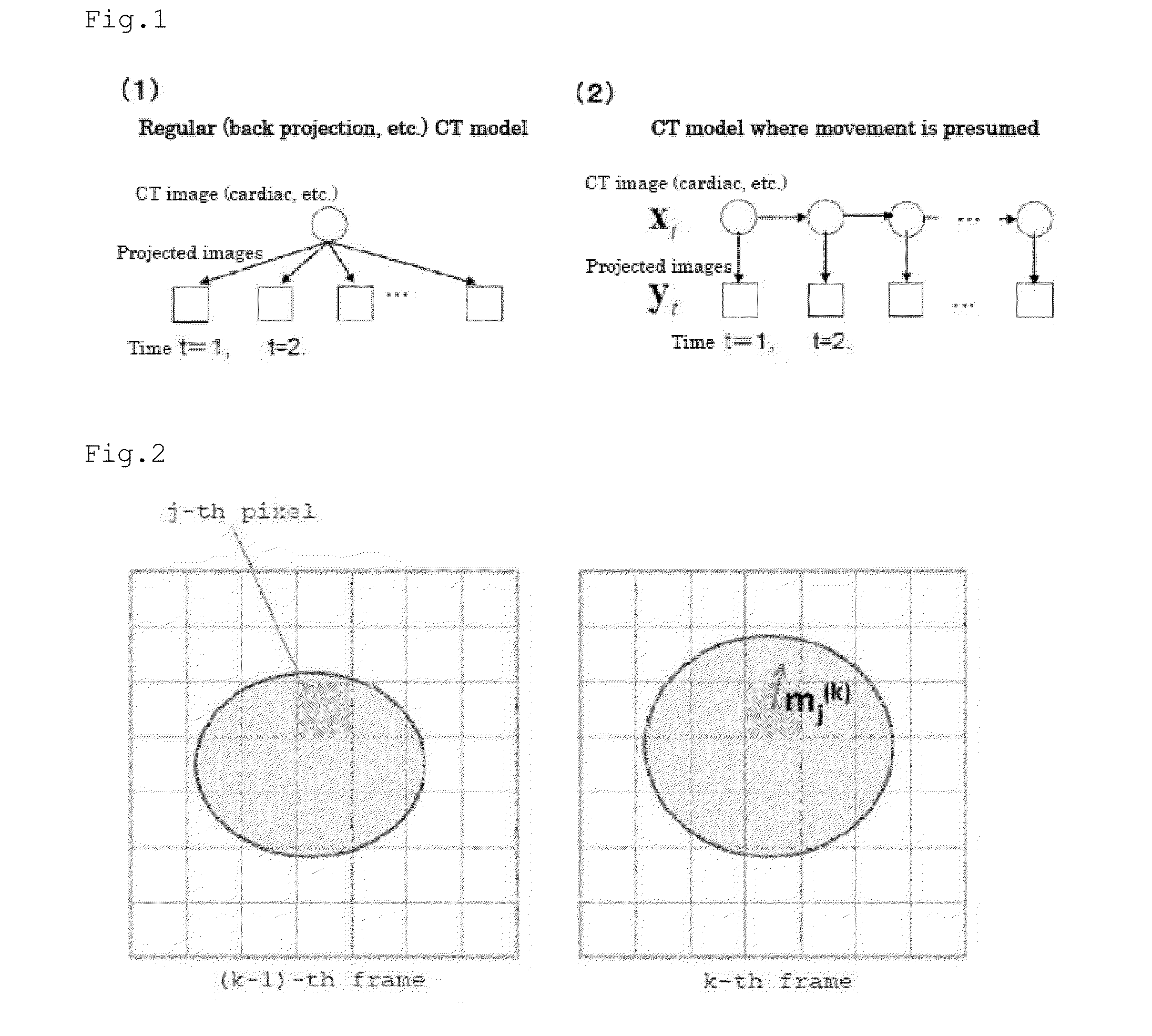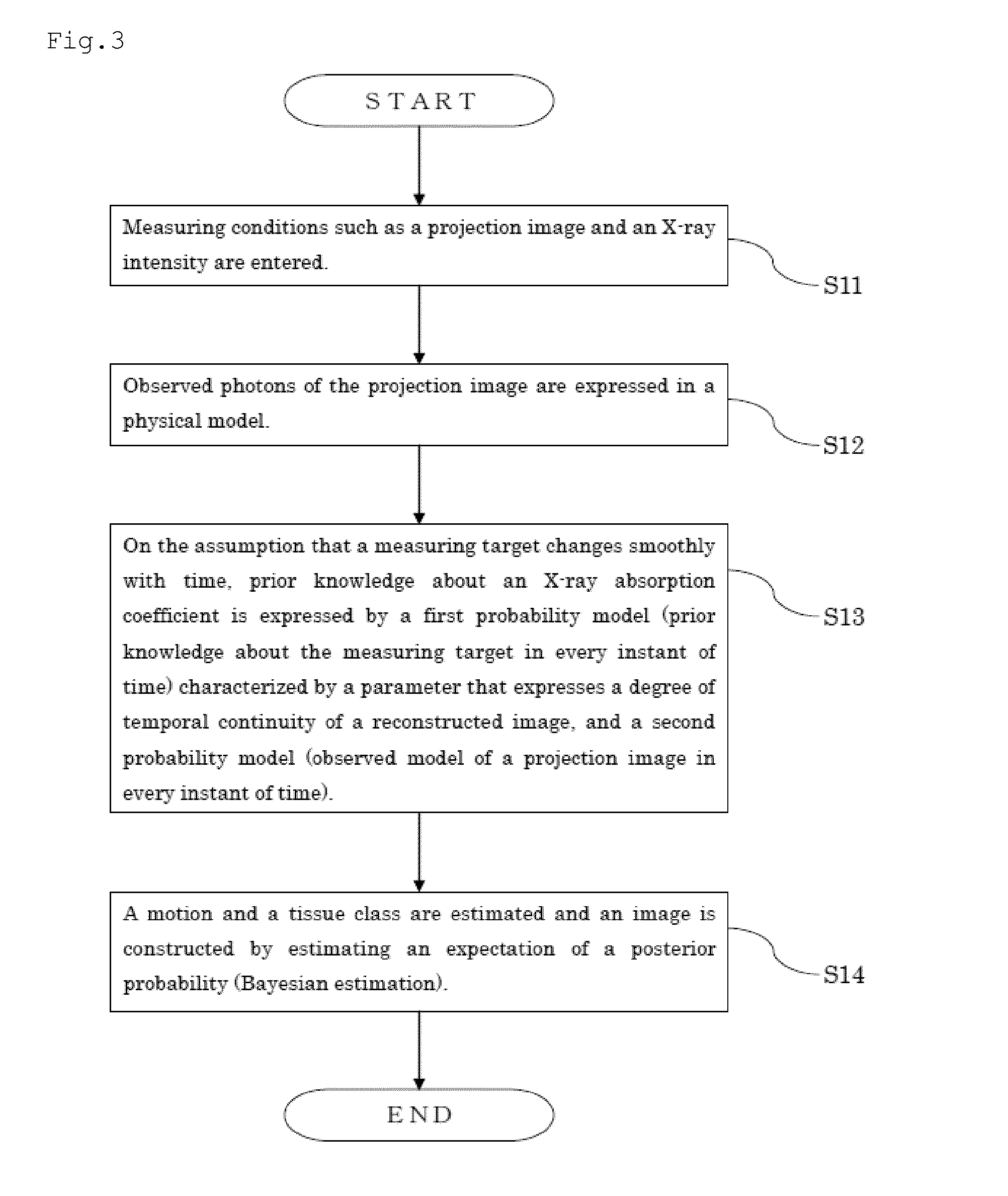Motion-tracking x-ray ct image processing method and motion-tracking x-ray ct image processing device
- Summary
- Abstract
- Description
- Claims
- Application Information
AI Technical Summary
Benefits of technology
Problems solved by technology
Method used
Image
Examples
embodiment 1
[0129]In Example 1, an object to be deformed was formed artificially and a screen was reconstructed based on a projection image of the object by calculator simulation using the motion tracking X-ray CT image processing method of the present invention. A result of the simulation is given below.
[0130]Images in FIG. 8 show an artificially formed image to be deformed. As shown in FIG. 8, a central area of each round screen shows the object (64×64 pixels). The object expanded from (a) to (e) with time. The deformation of the object is such that the object expanded at a rate differing between the vertical and horizontal directions.
[0131]FIG. 9 shows results of reconstruction of X-ray CT images. FIG. 9 is given to compare true images, results of image reconstruction obtained by a filtered back projection (FBP) method employed most frequently as a conventional method not assuming a motion, and results obtained by the image reconstruction of the present invention (suggested method).
[0132]Dif...
embodiment 2
[0138]The motion tracking X-ray CT image processing method of the present invention uses a probability model that makes statistical estimation as described above, so that it can incorporate other prior knowledge easily and can increase the quality of image reconstruction. As an example, making estimation in consideration of X-ray absorption coefficients representative of each tissue can enhance estimation accuracy. In this case, incorporating a hidden state variable to control the distribution of each tissue class can enhance estimation accuracy and can achieve robust estimation. The following describes experiment conducted to check the effect thereof.
[0139]FIG. 12 shows the X-ray absorption coefficient of an assumed tissue class and the value of the X-ray absorption coefficient of an object actually used in experiment. Here, it is assumed that there are four tissue classes including air, fat, muscle and bone, and that there is X-ray absorption coefficients representative of each ti...
embodiment 3
[0144]In Example 3, an X-ray CT algorithm is described different from that of Examples 1 and 2 described above.
[0145](1) Probability Model
[0146](1-a) Likelihood
[0147]ACT image of an object targeted for reconstruction is expressed by an one-dimensional vector X=[x1, . . . , xJ] (J is the number of pixels of a reconstructed image). Projection mentioned herein is to be made on an object to be deformed or to move with time. Accordingly, time is divided into K frames S{k}, kε{1, . . . , K} and a CT image in a k-th frame is expressed as X{k}=[x1{k}, . . . , xJ{k}]. CT images X{k} (kε{1, . . . , K}) in all the frames are expressed collectively as X={X{1}, . . . , X{k}}.
[0148]An image obtained by projection on the object at a time t is expressed as Y{t}=[y1{t}, . . . , y1{t}] (I is the number of detectors) and projections in all instants of time are expressed collectively as D={Y{1}, . . . , Y{T}}. It is assumed that projection of a CT image X(k) is obtained if the time t satisfies tεS(k). ...
PUM
 Login to View More
Login to View More Abstract
Description
Claims
Application Information
 Login to View More
Login to View More - R&D
- Intellectual Property
- Life Sciences
- Materials
- Tech Scout
- Unparalleled Data Quality
- Higher Quality Content
- 60% Fewer Hallucinations
Browse by: Latest US Patents, China's latest patents, Technical Efficacy Thesaurus, Application Domain, Technology Topic, Popular Technical Reports.
© 2025 PatSnap. All rights reserved.Legal|Privacy policy|Modern Slavery Act Transparency Statement|Sitemap|About US| Contact US: help@patsnap.com



